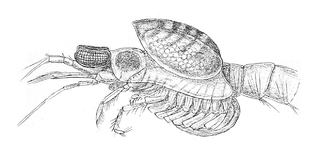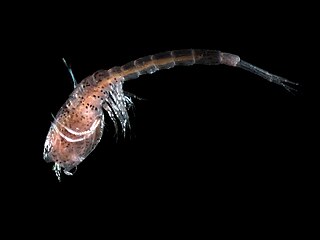Related Research Articles

Mysida is an order of small, shrimp-like crustaceans in the malacostracan superorder Peracarida. Their common name opossum shrimps stems from the presence of a brood pouch or "marsupium" in females. The fact that the larvae are reared in this pouch and are not free-swimming characterises the order. The mysid's head bears a pair of stalked eyes and two pairs of antennae. The thorax consists of eight segments each bearing branching limbs, the whole concealed beneath a protective carapace and the abdomen has six segments and usually further small limbs.

Mysidae is the largest family of crustaceans in the order Mysida, with over 1000 species in around 170 genera.
Tenagomysis is a genus of mysid shrimps in the family Mysidae, containing the following species:

Diastylis is a genus of crustaceans which belong to the family Diastylidae. It includes the following species:

Bodotriidae is a family of crustaceans belonging to the order Cumacea. Bodotriids have a worldwide distribution in shallow and deep waters. There are over 380 described species in over 30 genera, being the most diverse cumacean family. Their external morphology differs from other cumaceans by a combination of traits that independently are not unique to the family: the telson is fused to the last abdominal segment, the dorsal part of the mandible has a boat shape (naviculoid), exopods exist on the third maxilliped and the first peraeopod, and there is a uropodal endopod with one or two articles.

Acanthomysis is a genus of mysids, containing 28 species.
Cyclaspis is a genus of cumacean crustaceans in the subfamily Bodotriinae, containing the following species:

Campylaspis is a genus of crustaceans in the order Cumacea. Species of Campylaspis have a "bulky" carapace, which makes up more than 40% of the animal's length, as well as distinctive features of the mouthparts. There are currently 170 recognised described species:

Americamysis is a genus of mysid shrimps in the family Mysidae. The sensitivity of these shrimps to water quality makes them suitable for bioassays. Americamysis bahia and Americamysis almyra, which are used frequently to test for pesticides and other toxic substances, are often referred to as Mysidopsis bahia and Mysidopsis almyra in the literature.
Americamysis bahia is a shrimp-like crustacean in the order Mysida, the opossum shrimps. It is native to estuarine waters in Texas and Florida in the United States. It is often referred to in the literature as Mysidopsis bahia and is widely cultured and used in the laboratory for toxicology testing.
Americamysis almyra is a shrimp-like crustacean in the order Mysida, the opossum shrimps. It is native to estuarine waters in the western Atlantic Ocean and Gulf of Mexico. It is often referred to in the literature as Mysidopsis almyra.

Idiomysis is a genus of small mysids found in warm, shallow waters of Indian Ocean and Pacific.

The clade Multicrustacea constitutes the largest superclass of crustaceans, containing approximately four-fifths of all described crustacean species, including crabs, lobsters, crayfish, shrimp, krill, prawns, woodlice, barnacles, copepods, amphipods, mantis shrimp and others. The largest branch of multicrustacea is the class Malacostraca.

Erythrops is a genus of marine crustaceans in the family Mysidae.

Eudorella is a genera of marine hooded shrimp in the family Leuconidae. Their skeletons are chitinous.
Parapseudidae is a family of crustaceans belonging to the order Tanaidacea.

Parapseudinae is an estuarine subfamily of crustacean in the order Tanaidacea.

Anisomysis is a genus of mysids, first described in 1910 by Hans Jacob Hansen.

Cumopsis is a genus of crustaceans in the family Bodotriidae originally described by G.O. Sars in 1878, the type species is Cumopsis goodsir.
References
- 1 2 WoRMS (2013). "Mysidopsis G.O. Sars, 1864". WoRMS. World Register of Marine Species . Retrieved 2014-02-06.